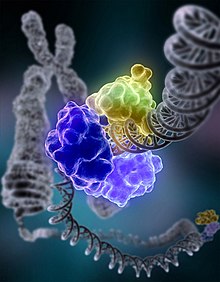DNA Ligase
| DNA ligase | |||||||||
|---|---|---|---|---|---|---|---|---|---|

DNA ligase repairing chromosomal damage
|
|||||||||
| Identifiers | |||||||||
| EC number | 6.5.1.1 | ||||||||
| CAS number | 9015-85-4 | ||||||||
| Databases | |||||||||
| IntEnz | IntEnz view | ||||||||
| BRENDA | BRENDA entry | ||||||||
| ExPASy | NiceZyme view | ||||||||
| KEGG | KEGG entry | ||||||||
| MetaCyc | metabolic pathway | ||||||||
| PRIAM | profile | ||||||||
| PDB structures | RCSB PDB PDBe PDBsum | ||||||||
| Gene Ontology | AmiGO / EGO | ||||||||
|
|||||||||
| Search | |
|---|---|
| PMC | articles |
| PubMed | articles |
| NCBI | proteins |
| ligase I, DNA, ATP-dependent | |
|---|---|
 |
|
| Identifiers | |
| Symbol | LIG1 |
| Entrez | 3978 |
| HUGO | 6598 |
| OMIM | 126391 |
| RefSeq | NM_000234 |
| UniProt | P18858 |
| Other data | |
| Locus | Chr. 19 [1] |
| ligase III, DNA, ATP-dependent | |
|---|---|
| Identifiers | |
| Symbol | LIG3 |
| Entrez | 3980 |
| HUGO | 6600 |
| OMIM | 600940 |
| RefSeq | NM_002311 |
| UniProt | P49916 |
| Other data | |
| Locus | Chr. 17 q11.2-q12 |
DNA ligase is a specific type of enzyme, a ligase, (EC 6.5.1.1) that facilitates the joining of DNA strands together by catalyzing the formation of a phosphodiester bond. It plays a role in repairing single-strand breaks in duplex DNA in living organisms, but some forms (such as DNA ligase IV) may specifically repair double-strand breaks (i.e. a break in both complementary strands of DNA). Single-strand breaks are repaired by DNA ligase using the complementary strand of the double helix as a template, with DNA ligase creating the final phosphodiester bond to fully repair the DNA.
DNA ligase is used in both DNA repair and DNA replication (see Mammalian ligases). In addition, DNA ligase has extensive use in molecular biology laboratories for recombinant DNA experiments (see Applications in molecular biology research). Purified DNA ligase is used in gene cloning to join DNA molecules together to form recombinant DNA.
The mechanism of DNA ligase is to form two covalent phosphodiester bonds between 3' hydroxyl ends of one nucleotide ("acceptor"), with the 5' phosphate end of another ("donor"). ATP is required for the ligase reaction, which proceeds in three steps:
Ligase will also work with blunt ends, although higher enzyme concentrations and different reaction conditions are required.
...
Wikipedia
